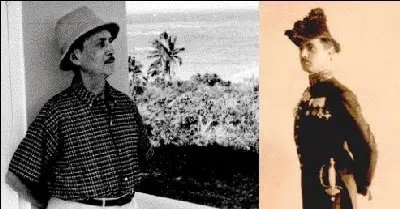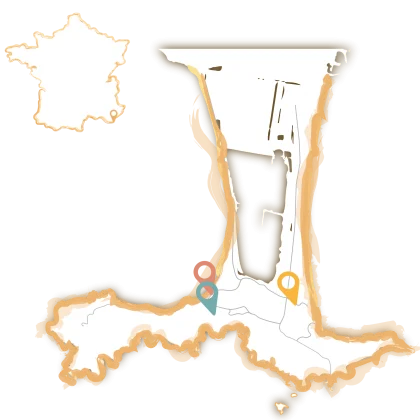Saint John Perse
The story of a French diplomat turned writer
Saint John Perse was both a poet and a diplomat. His tomb is in the Giens cemetery, just 300 m from the Clair de Lune campsite in Hyères. Born in 1887 in Guadeloupe, his literary work made him more famous than his work for the French Foreign Office…
Saint John Perse is just a pseudonym; he answers to the name of Alexis Léger, one of the most distinguished diplomats of the Third Republic, and a famous figure in French foreign policy between the wars.
The son of a colonist, he spent his childhood in the West Indies, where he became attached to nature and its riches. He returned to France in 1899 to continue his studies in Pau, then Bordeaux, and embarked on a diplomatic career. He became Secretary General for Foreign Affairs in 1933. An avid traveler, he gave up the literary world to concentrate on his profession.
He gave up his official position in 1940, dismissed by the Vichy government and stripped of his French nationality. He went to the United States to take part in a resistance movement. He did not return to France until 1957. He was awarded the Nobel Prize for Literature in 1960.
In the world of literature, his name Saint-John Perse is attributed to one of the finest works of 20th-century French poetry, still less known to the world.
For most of his life, the man tried to keep the author and the statesman scrupulously separate, leading a double life between the slower composition of a rather fastidious poetic oeuvre and his profession as a senior civil servant, which took him to the top of the Republic’s spheres. (He held the post of Secretary General of the Ministry of Foreign Affairs from 1933 to 1940)
Saint-John Perse has often been misjudged by being associated with images of division: Janus “the bifid poet” and many others… He undoubtedly reflects the image of an “undivided poet” (he evoked this term during his Nobel Prize acceptance speech).

Saint John Perse and key dates :
- 1887: Birth of Alexis Leger in Pointe-à-Pitre
- 1887-1899: Childhood in the West Indies and studies up to fifth grade at the Lycée Carnot in Pointe-à-Pitre.
- March 1899: Alexis Leger’s family moves to France with Augusta, his paternal grandmother, and settles in Pau. Studies at the Lycée de Pau (which today bears his poet’s name) until the baccalauréat. Meets Francis Jammes.
- 1904: Studies at Bordeaux Law School, then at the Faculty of Medicine, Science and Literature.
- 1905: Meets Paul Claudel, introduced to him by Jammes, in Orthez. Claudel and Jammes try in vain to convert him.
- 1907: Death of his father.
- 1908: Death of his grandmother.
- 1910: Law degree.
- 1911: Publication of Eloges. Meets Valery Larbaud. Prepares competitive examination for the Foreign Office.
- 1912: Trip to England. Meeting with Joseph Conrad.
- 1914: A. L. passed his entrance exam for the French Foreign Service.
- 1916: Meeting with Paul Valéry.
- 1916-1921: Embassy secretary in China. Wrote Anabase and Amitié du Prince, published on his return.
- 1921: Meets Aristide Briand, with whom he develops a close friendship. Attached to the Quai d’Orsay in Paris.
- 1921-1940: abandoned his literary activities and devoted himself to his diplomatic duties. He became Secretary General to the Minister of Foreign Affairs in 1933, a post he held until 1940.
- 1925: Participates in the Locarno conference.
- 1927: He was instrumental in the adoption of the Briand-Kellog Pact, a treaty “renouncing war as an instrument of national policy”.
- 1929: Death of his maternal grandmother.
- 1932: Death of Aristide Briand. Saint-John Perse has an affair with Lilita Abreu, a Cuban living in France, and they are closely linked in literary circles.
- 1936: Hitler announces the cancellation of the Locarno Pact and reinforces the arms on the left bank of the Rhine. A. L. opposes Hitler and orders an armed execution against him.
- 1938: Accompanies his minister to the Munich Conference.
- 1940: Dismissed under odious conditions by armistice supporters, he went into exile in the USA. In October, he was stripped of his French nationality, stripped of the Légion d’Honneur and stripped of his property. His rights were restored at the Liberation.
- 1940-1957: Exiled to the United States, where he received permanent resident status in 1949. Resides in Washington, where he works at the Library of Congress until 1946. Supported by the Bollingen Foundation, he returned to poetry (Exil, 1941-1944, Vents, 1946 then Amers, 1957). He maintained or strengthened his ties with Roger Caillois, Jean Ballard and Jean Paulhan. His relationship with Lilita Abreu, who had accompanied him to Washington, ended in 1944. Throughout these years, he traveled regularly on cruises, including to the English West Indies, but never returned to Guadeloupe.
- 1957: Return to France. From then on, he spent winters in the United States and summers in France, at Les Vigneaux, on the Giens peninsula, in the Polynesian estate where Valéry had once lived.
- 1958: Marries Dorothy Milburn Russell in America. Renames her Diane.
- 1959: Awarded the Grand Prix National des Lettres in Paris and the Grand Prix International de Poésie at the Biennale de Knocke le Zoute in Belgium.
- 1960: Stays in Argentina. Just after the publication of Chronique, receives the Nobel Prize.
- 1963: Edition of Oiseaux, preceded by the 1962 publication by Le Vent d’Arles of L’Ordre des Oiseaux, in which the poems are accompanied by etchings by Braque.
- 1965: Trip to Italy. Delivered the Discourse for Dante in Florence, for the seventh centenary of the poet’s birth.
- 1969: Sung by Celle qui fut là.
- 1970-1975: Never left Les Vigneaux, where he died on September 20, 1975. Publication in 1971 of Chant pour un équinoxe, in 1973 of Nocturne, in 1974 of Sécheresse.
- 1972: Publication of the Pléiade, which he took over entirely.
- 1976: Inauguration of the Fondation Saint-John Perse in Aix-en-Provence. Just before his death, at the instigation of Pierre Guerre, a lawyer and man of letters from Marseilles, the poet donated his entire collection to the city of Aix-en-Provence. The fundamental task of the Fondation Saint-John Perse is to preserve and promote this prestigious collection, unique in the history of French literature in this century.

